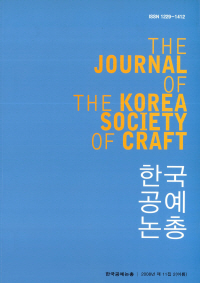- 영문명
- A Study on the Yugijang[鍮器匠], who cast the utensils used in religious sacrifices[祭器] for the royal family late in the Joseon Dynasty
- 발행기관
- 한국조형디자인학회
- 저자명
- 장경희(Jang, kyung-hee)
- 간행물 정보
- 『조형디자인연구』한국공예논총 제11집 2권, 1~24쪽, 전체 24쪽
- 주제분류
- 예술체육 > 미술
- 파일형태
- 발행일자
- 2008.06.30
5,680원
구매일시로부터 72시간 이내에 다운로드 가능합니다.
이 학술논문 정보는 (주)교보문고와 각 발행기관 사이에 저작물 이용 계약이 체결된 것으로, 교보문고를 통해 제공되고 있습니다.

국문 초록
영문 초록
The Joseon Dynasty, a Confucian state, decided to rule the nation on the principle of courtesy, and the events hosted by the royal family were also conducted according to courtesy (the five courtesy principles). In particular, the sacrificial rites performed by the royal family were a national event to show off the principle of 'loyalty and filial piety'; so, the utensils used in religious services were cast with the nation's full capability. Manufacturing of the utensils used in religious services for the royal family began to be
systematized during the rule of King Sejong early in the Joseon Dynasty and the systematization was completed at the time of King Seongjong, who compiled "The National Five Principles of Courtesy." Meanwhile, the utensils used in religious services for the royal family were produced by a temporary government office called "the Competent Authority," which was set up as needed. This thesis aims to analyze an ancient book entitled "the
Competent Authority for Ritual Principles" in order to understand the actual state of brass-ware craftsmen mobilized to the temporary government office to cast the utensils used in religious services for the royal family late in the Joseon Dynasty. The following are a summary of the findings. First of all, early in the 17th century, King Gwanghaegun and King Injo established three times a temporary government office called "the Competent Authority for Religious Services utensils" in order to completely prepare the utensils used in religious services for the royal family, which were scattered or destroyed due to the Japanese invasion in 1592. As a result, two kinds of the utensils of such a kind were equipped in 1601 and five kinds in 1605.
Moreover, in 1612, about 80 kinds of brass-ware utensils used in religious services were cast, and all the dished needed for the shrine for the founder of the nation, guardian deities of the nation, royal tombs, and shrines for ghosts were entirely equipped. Next, the utensils used in religious services for the royal family were newly produced when the king died and repaired when they were broken or crushed. For example, the utensils
used in religious services at the ancestral shrine of the royal family or the guardian deities of the nation would be frequently examined and mended if needed since they were used for each national sacrificial rite (called "an auspicious rite"). When the king or the queen died (there was performed "an evil rite"), a temporary government office called "the Competent Authority for Shrines for Ghosts" was erected and the utensils were newly manufactured so that they might be used for the sacrificial rites performed before the king tombs[mountain tombs] or within the shrines for ghosts. In this regard, a chronological summary of
manufacturing processes of the utensils used in religious services for the royal family produced between the 17th century and the 19th century is listed below. First, in the 17th century, a dish used in religious services for the royal family was manufactured by 6-8 brass-ware craftsman deployed to a temporary government office called "the Competent Authority for Shrines for Ghosts(殯殿魂殿都監)." Copper, a material of the
utensils, was imported from Japan, and a team of eight brass-ware craftsman manufactured the dish against a drawing created by a painter. Most of the artisans (capital craftsmen, 京工匠) lived in Seoul and their skill was so good that they were continuously mobilized for 10 years.
목차
Ⅰ. 서 론
Ⅱ. 조선전기 왕실제기의 禮制구축
Ⅲ. 17세기초 廟社陵殿제기의 제작 실태
Ⅳ. 조선후기 유기장의 陵殿祭器鑄成
Ⅴ. 결 론
n 참고문헌
키워드
해당간행물 수록 논문
참고문헌
관련논문
예술체육 > 미술분야 NEW
- 한국서비스디자인학회 2025년 춘계학술대회 목차
- 요식업 점주의 컨텍스트 정보 수집 및 예측을 통한 매장관리 서비스 - 배달 플랫폼을 중심으로
- AI를 통한 캐릭터 생성에 필요한 캐릭터의 Uniqueness 요소 분석에 관한 연구
최근 이용한 논문
교보eBook 첫 방문을 환영 합니다!

신규가입 혜택 지급이 완료 되었습니다.
바로 사용 가능한 교보e캐시 1,000원 (유효기간 7일)
지금 바로 교보eBook의 다양한 콘텐츠를 이용해 보세요!




